How to Handle Abusive Customers: 8 Effective Tips
Discover effective strategies for managing abusive customers. Learn how to remain calm, set boundaries and turn challenging interactions into opportunities for improved service.

Discover effective strategies for managing abusive customers. Learn how to remain calm, set boundaries and turn challenging interactions into opportunities for improved service.

Delivering exceptional customer service is crucial but what do you do when interactions worsen and customers become abusive? Such situations can leave even the most experienced professionals feeling overwhelmed. The repercussions of abusive customers extend beyond a single encounter, impacting employee morale and potentially harming your company’s reputation. 41% of customers reported anger when they experienced a poor customer care experience.
Effective strategies exist to navigate the challenges. You can diffuse tension and even turn difficult interactions into positive outcomes by adopting the right approaches. Let’s check out the proven methods for handling abusive customers, equipping you and your team to maintain professionalism in the toughest situations.
Abusive customers refer to disrespectful behavior towards employees or businesses, which can manifest as verbal abuse, threats, intimidation or even physical aggression. Such actions breach social norms and ethical standards of customer behavior.
Frustration with poor service, unmet expectations or personal stress may lead to emotional outbursts. Some individuals may feel entitled or use aggression as a manipulation tactic. Miscommunication, cultural differences or mental health challenges can play a role. Customers may have learned that aggressive behavior gets results in some cases, reinforcing the negative interactions.
Key objectives:
Explore the various advantages of mastering the art of handling abusive customers and how doing so can significantly impact your workplace culture.
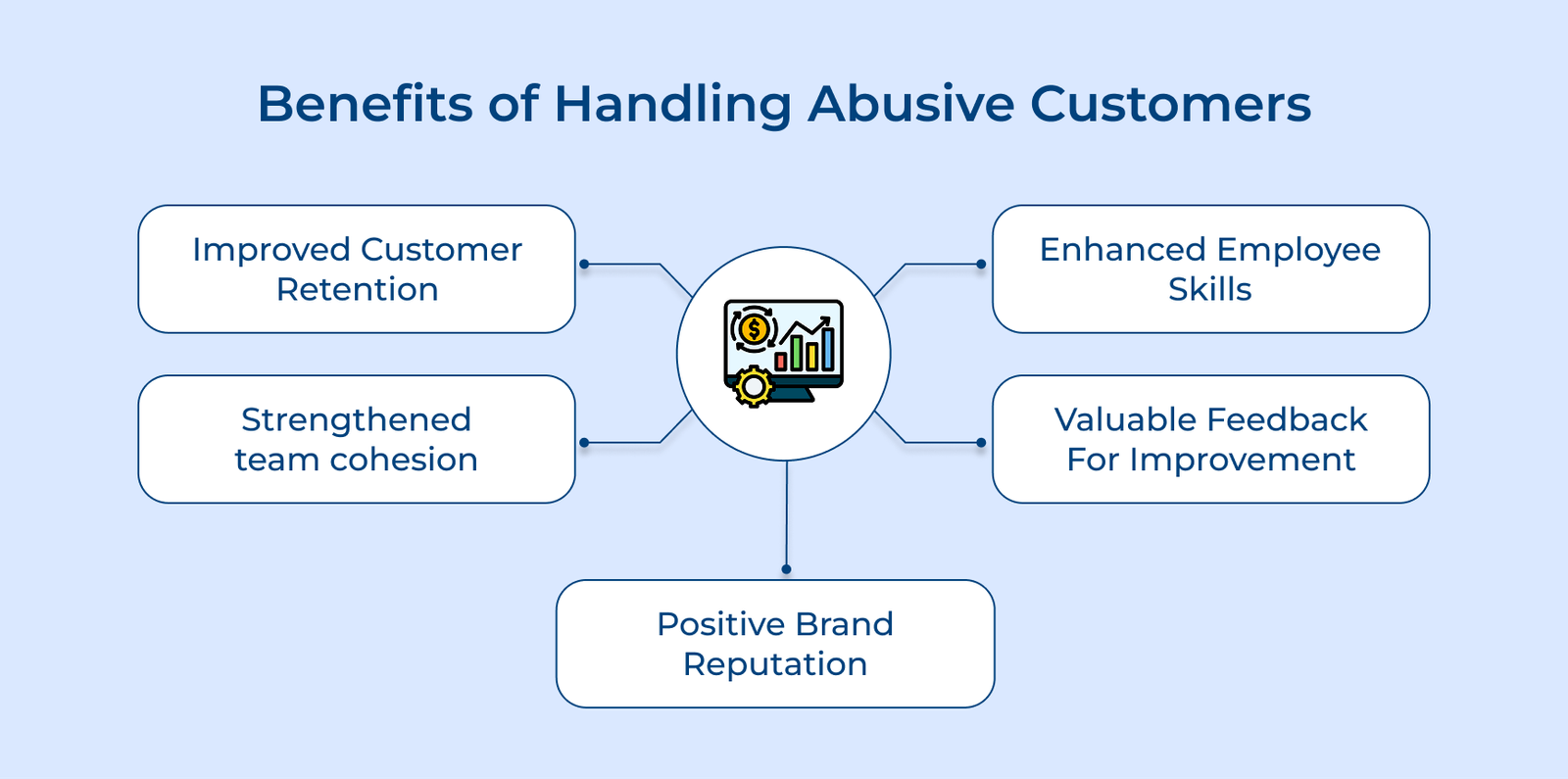
1. Improved customer retention: Effectively managing challenging interactions can transform negative experiences into positive ones. When addressed with professionalism, even abusive customers can become loyal patrons, impressed by your problem-solving abilities and commitment to service.
2. Enhanced employee skills: Handling abusive customers equips employees with essential skills in conflict resolution, emotional intelligence and communication. They learn to stay calm under pressure and develop effective strategies for de-escalating tense situations, benefiting their professional lives.
3. Strengthened team cohesion: Challenging customer interactions often call for teamwork. Employees can strengthen camaraderie and boost morale by supporting one another through difficulties, enhancing teamwork within the organization.
4. Valuable feedback for improvement: Even abusive customers can shed light on real issues within a company’s products or services. Businesses can pinpoint areas for improvement and enhance customer experience by addressing their complaints without condoning the behavior.
5. Positive brand reputation: How a company manages difficult customers can greatly influence its public image. When people hear about a business’s skill in handling tough situations, it boosts its reputation for outstanding customer service and conflict resolution.
Identifying abusive customers early can help staff prepare for and manage difficult interactions more effectively. Here are six common signs of such customers:
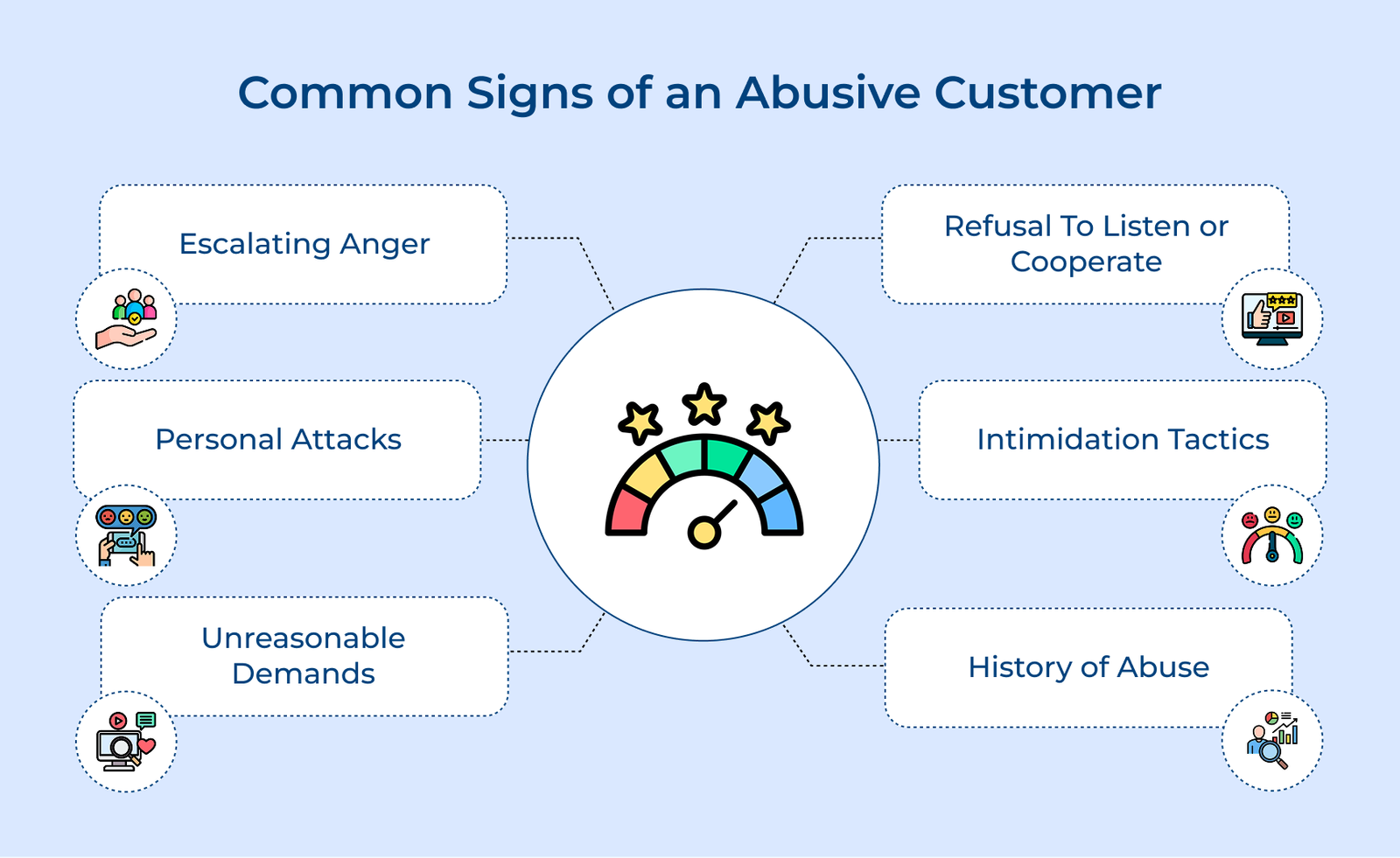
Abusive angry customers often start calmly but can quickly spiral into escalating anger. They may raise their voices, use aggressive language, or threaten even when staff genuinely tries to help.
Abusive customers often resort to personal insults, targeting staff members with derogatory comments about their intelligence, appearance or competence. The attacks aim to intimidate and belittle rather than address the actual issue.
While it’s natural for customers to have high expectations, abusive individuals often make unreasonable demands. They might insist on immediate resolutions for complex issues, request to speak with executives over minor concerns or seek compensation that far exceeds the problem at hand.
Abusive customers often seem more focused on venting their frustrations than resolving the issue. They may interrupt staff, withhold essential information and dismiss proposed solutions, indicating a lack of genuine interest in finding a resolution.
Some abusive customers resort to intimidation tactics to get their way, such as threatening to damage the company’s reputation on social media, hinting at legal action for minor issues or even making veiled threats of physical harm.
Repeat customers with a history of abusive behavior are likely to continue the pattern. Records of past aggression, threats or unreasonable demands serve as strong indicators that they may act out again.
Check out the effective strategies for dealing with abusive customers with grace, ensuring both your peace of mind and your company’s integrity are safeguarded.
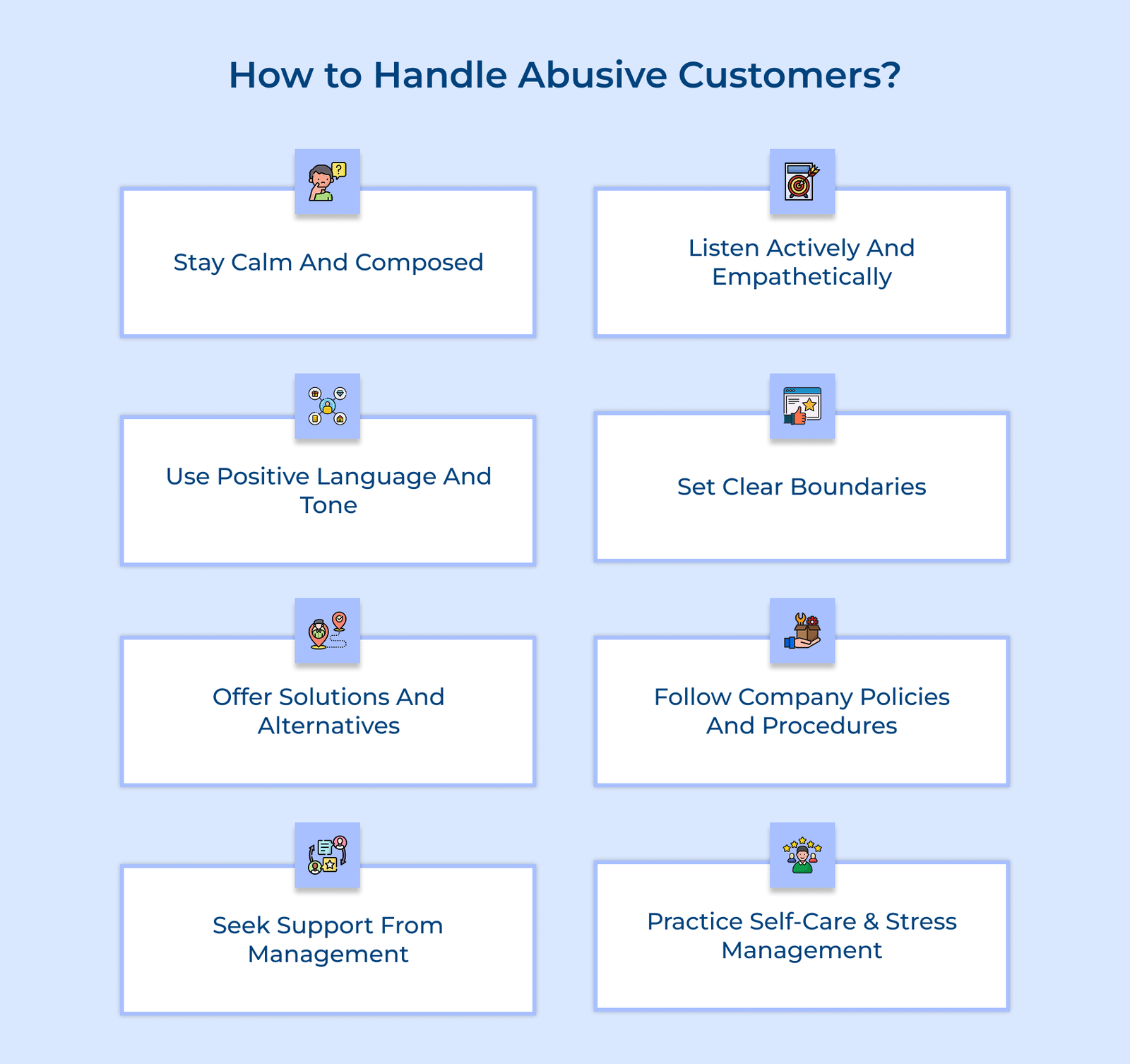
Staying calm when dealing with abusive customers is essential for effective resolution. Recognize your triggers and develop strategies to respond rationally rather than react emotionally to manage your emotions.
Breathing techniques, like deep diaphragmatic breathing, can help you regulate stress. Combine it with a professional demeanor, proper posture, facial expressions and tone of voice to create a calm presence that can often defuse tension.
Pro Tips:
You can offer a valuable outlet for the customer’s emotions and show respect for their concerns by letting them vent without interruption, which can help defuse their anger.
As you listen, aim to uncover the root cause of their frustration often, the surface issue hides a deeper concern. Acknowledge their feelings with empathetic phrases, maintaining professional boundaries without condoning their abusive behavior.
Pro tips:
The language and tone you use can greatly influence the conversation. Steer clear of confrontational phrases like “You’re wrong” or “That’s not our policy.” Instead, adopt a positive, solution-oriented approach to address the customer’s concerns.
Speaking in a calm, measured voice enhances professionalism and can help soothe an agitated customer. Even if they become louder or more aggressive, maintaining your composure can prevent the situation from escalating further.
Actionable tips:
While empathy is important, it’s essential to establish clear boundaries with abusive clients. Politely but firmly address unacceptable behavior, emphasizing that while you want to help, abusive language won’t be tolerated. It sets a respectful tone and upholds employee dignity.
Be prepared to outline the consequences of continued abuse, such as terminating the call or asking the customer to leave. If the behavior persists, follow through on the actions, prioritizing the safety and well-being of yourself along with your colleagues.
Actionable tips:
Addressing the customer’s underlying concerns is crucial for resolution. Once you pinpoint the root of the problem, focus on providing clear solutions or alternatives. The approach demonstrates your commitment to helping them, often diffusing their anger and shifting the conversation toward a more positive outcome.
When presenting options, clearly explain how each addresses their specific issue. Even if the solutions aren’t perfect, your effort to find resolutions can transform a negative experience into a positive one.
Actionable tips:
Following established guidelines for managing difficult customers ensures a consistent approach while safeguarding you and the company. Familiarize yourself with the policies, including escalation procedures, to boost your confidence and stay within approved parameters.
Thoroughly document any abusive interactions, noting what was said, actions taken and resolutions offered. The record will be invaluable for future reference, training and any necessary legal or procedural follow-ups.
Pro tips:
Don’t hesitate to seek support when facing tough customers. Your colleagues are there to help and their expertise can improve outcomes. Sometimes, having another person present can shift the dynamic of a challenging interaction.
After resolving a complex issue, debrief with your supervisors. It allows you to process the experience and receive feedback, equipping you with additional strategies for future situations. It’s a valuable learning opportunity for your organization.
Actionable tips:
Developing effective coping strategies after tough encounters is vital for long-term success in customer service. Consider taking a short walk, practicing deep breathing or discussing the situation with a supportive colleague. Acknowledge that the interactions can be emotionally draining and allow yourself time to recover.
Regular breaks during work hours can help maintain emotional resilience, giving you a chance to reset mentally and physically. Outside of work, engage in enjoyable stress-relieving activities like exercise, hobbies or spending time with loved ones.
Best practices:
The escalation process for handling abusive customers is crucial for maintaining a safe and productive work environment while still attempting to address customer concerns.
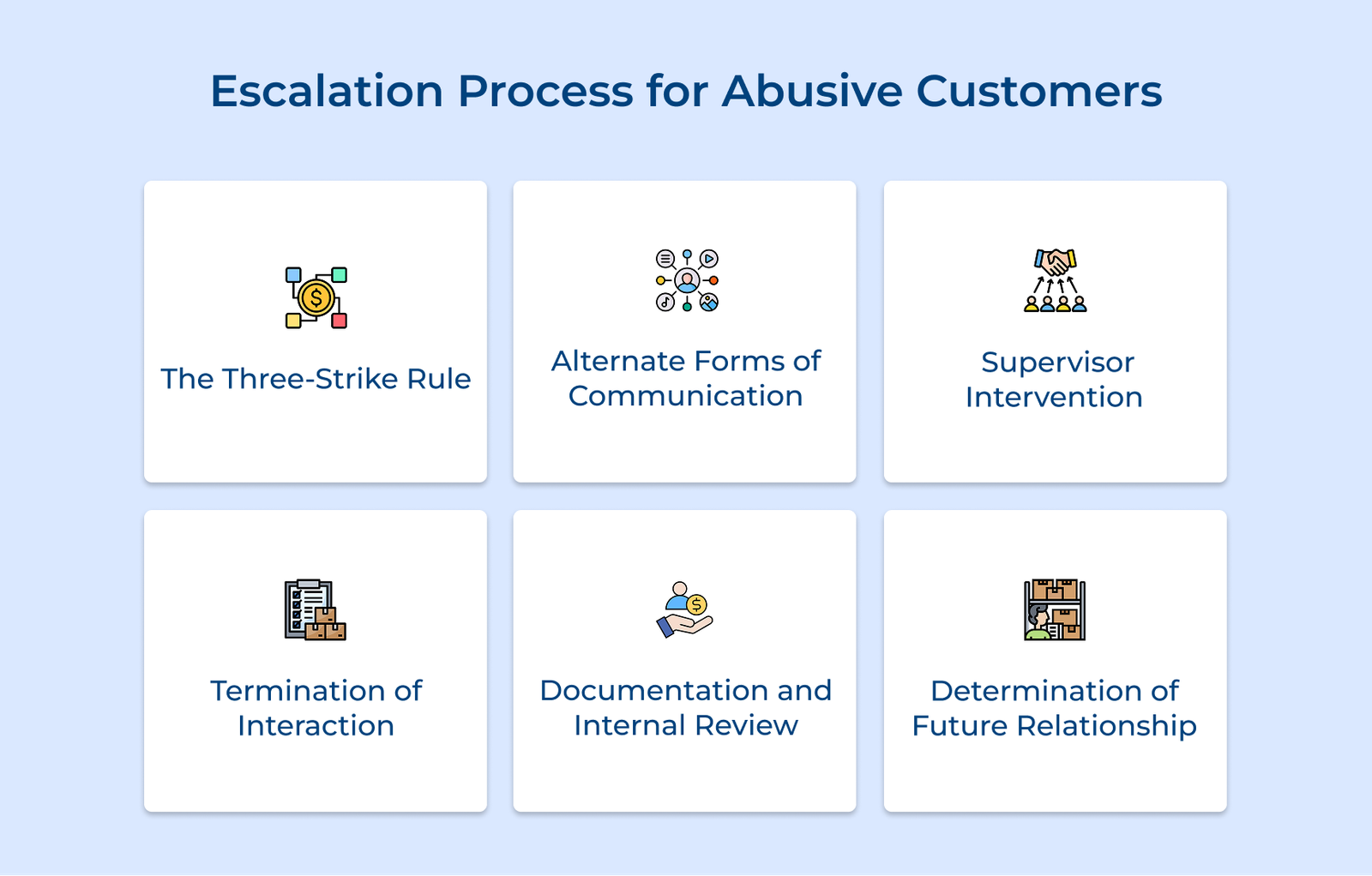
The strategy sets clear boundaries while giving customers opportunities to correct their behavior. The first “strike” is a polite but firm warning about their conduct. The second strike reiterates this warning and outlines the consequences of continued abuse. The final strike implements those consequences. The approach ensures fairness and allows customers ample chances to adjust before more serious actions are taken.
Changing communication methods can effectively de-escalate tense situations. Let’s assume that if a customer is abusive on the phone, suggesting they continue via email gives them time to cool off and express their concerns more constructively. If in-person interactions become heated, proposing a switch to phone or online support can reset the conversation. The shift often disrupts escalating emotions and sets the stage for a more productive dialogue.
If the employee can’t de-escalate the situation, bringing in a supervisor can be a powerful next step. Supervisors typically have more authority to make decisions and offer solutions, which can help satisfy the customer. A higher-ranking employee’s presence often encourages abusive customers to temper their behavior. The supervisor also provides support and guidance, reassuring the front-line employees that they have management backing.
If abuse persists despite warnings and de-escalation efforts, it may be necessary to terminate the interaction. It could mean hanging up the phone, asking the customer to leave or stopping email correspondence. Employee safety and well-being should always come first. Having clear guidelines on when and how to end an interaction ensures consistency.
Every instance of customer abuse must be meticulously documented, including the interaction details, staff actions and outcomes. The documentation serves several purposes: it aids in refining future responses, provides a record for potential legal issues and helps track repeat offenders. Regular internal reviews can uncover trends, enabling the improvement of company policies and training.
After a serious incident of customer abuse, it’s crucial to evaluate whether to continue the business relationship. The decision should consider the severity of the abusive behavior, the customer’s value to the company and the impact on employee morale. Terminating the relationship may be necessary in some cases, with clear communication that their business is no longer welcome.
Check out the practical tips for preventing burnout and preserving your well-being while dealing with even the most challenging callers.
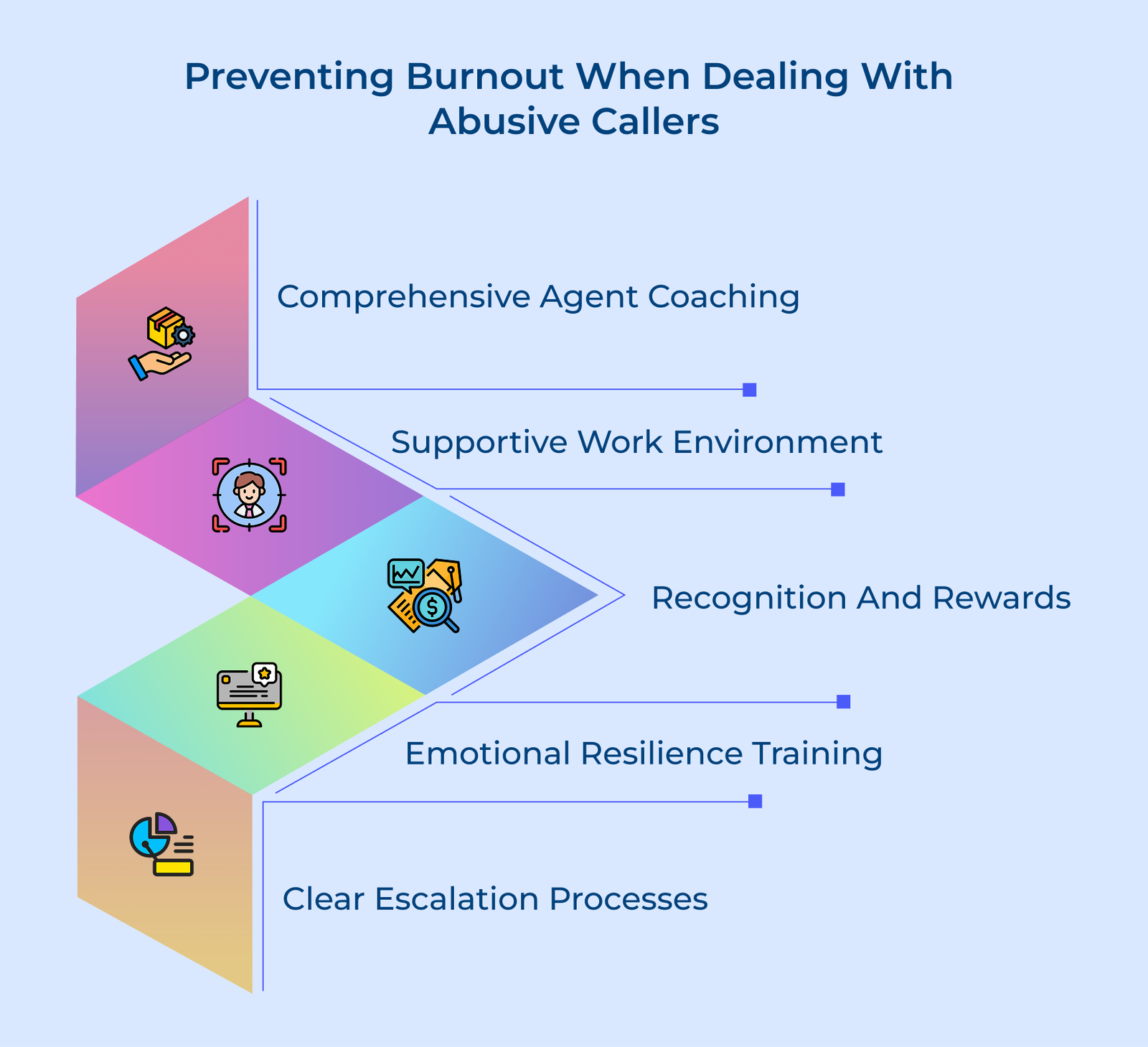
1. Comprehensive Agent Coaching
Effective coaching goes beyond teaching technical skills to include emotional management techniques. Coaches should focus on strategies for de-escalation, active listening and maintaining professionalism under pressure. Role-playing exercises allow agents to practice the skills in a safe environment before facing real challenges.
Regular feedback sessions provide opportunities to address specific improvements and reinforce positive behaviors. The ongoing support boosts agents’ confidence and competence, helping to reduce stress when dealing with difficult customers.
2. Supportive Work Environment
Enhancing a supportive work environment is crucial for preventing burnout. Encouraging a culture where agents feel comfortable discussing challenging calls with peers and supervisors can create a vital support network. Team-building activities further strengthen the relationships.
Management should prioritize employee well-being by actively listening to concerns and taking meaningful action. An open-door policy empowers agents to seek help when needed, ensuring they don’t have to face challenges alone.
3. Emotional Resilience Training
Emotional resilience is essential for managing abusive callers without experiencing burnout. Training programs should emphasize techniques such as mindfulness, cognitive reframing and stress management, empowering agents to navigate negative interactions.
Offering regular workshops on emotional intelligence equips agents with tools to manage their emotional responses and recover swiftly from difficult encounters.
5. Recognition And Rewards
Recognizing the difficulty of handling abusive callers and celebrating agents who excel in the situations can significantly boost morale. Create a system to highlight outstanding performances, utilizing peer nominations or customer feedback.
Offer both monetary and non-monetary rewards for consistent excellence, such as bonuses, additional time off or opportunities for professional development.
6. Clear Escalation Processes
Establishing clear escalation procedures can alleviate stress for agents by providing a straightforward action plan for handling difficult calls. Ensure that all agents are well-trained and empowered to utilize the protocols when needed.
Regularly refine the processes based on agent feedback or call outcomes, reinforcing that their input is valued and that the company is dedicated to enhancing their work experience.
Mastering the art of managing abusive customers is crucial. It not only protects employee well-being but also upholds the company’s reputation and customer relationships. Navigating challenging interactions with professionalism shows a commitment to customer satisfaction, even in tough situations.
Skillfully handling abusive customers can transform negative experiences into positive ones, turning detractors into loyal advocates. The capability boosts customer retention, sparks positive word-of-mouth and drives business growth. It offers valuable insights for enhancing products, services and processes, leading to business improvement.
Terminate the interaction if the customer persists in abusive behavior despite warnings, displays threats, uses hate speech or discriminatory language or causes significant distress to the employee without any progress being made.
Businesses can transform negative experiences into positive ones by delivering exceptional service, exceeding expectations with effective solutions, following up for satisfaction and using feedback to enhance processes. It not only boosts reputation but also fosters customer loyalty.
Businesses must ensure a safe work environment for employees, which may include refusing service to abusive customers. It’s vital to consider privacy laws when documenting incidents, adhere to anti-discrimination laws in responses and be aware of potential liability in case of threats.
Prioritize emotional control to maintain professionalism with abusive clients. Practice deep breathing to stay calm and focus on the issue rather than the person. Use neutral, solution-oriented language and don’t take insults personally. If necessary, take brief breaks to regroup. Remember, your professionalism reflects the company, not the customer’s behavior.
Abusive customers frequently exhibit escalating anger, resort to personal attacks or threats and make unreasonable demands. They often refuse to listen or cooperate, use intimidation tactics and may have a history of such behavior. Their hostility typically exceeds normal frustration, leading to persistent aggression toward staff.
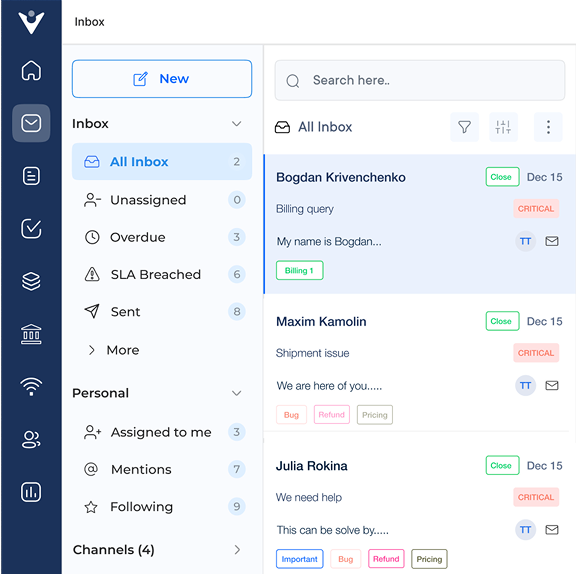
Market better, sell faster and support smarter with Veemo’s Conversation Customer Engagement suite of products.
Unify all your customer data in one platform to deliver contextual responses. Get a 360 degree view of the customer lifecycle without switching tools.
Connect with the tools you love to reduce manual activities and sync your business workflows for a seamless experience.
 https://veemo.io/wp-content/uploads/2024/12/customer-service-response-time.png
1256
2400
Webvision Solution
https://veemo.io/wp-content/uploads/2024/11/veemo.svg
Webvision Solution2025-10-17 10:51:142025-10-17 10:51:149 Effective Tips to Reduce Customer Service Response Time
https://veemo.io/wp-content/uploads/2024/12/customer-service-response-time.png
1256
2400
Webvision Solution
https://veemo.io/wp-content/uploads/2024/11/veemo.svg
Webvision Solution2025-10-17 10:51:142025-10-17 10:51:149 Effective Tips to Reduce Customer Service Response Time https://veemo.io/wp-content/uploads/2024/10/How-to-Create-Knowledge-Base.png
1257
2400
Vikas Sachan
https://veemo.io/wp-content/uploads/2024/11/veemo.svg
Vikas Sachan2024-10-21 12:24:342025-11-03 07:13:21How to Create a Knowledge Base in 9 Easy Steps: The Ultimate Guide
https://veemo.io/wp-content/uploads/2024/10/How-to-Create-Knowledge-Base.png
1257
2400
Vikas Sachan
https://veemo.io/wp-content/uploads/2024/11/veemo.svg
Vikas Sachan2024-10-21 12:24:342025-11-03 07:13:21How to Create a Knowledge Base in 9 Easy Steps: The Ultimate Guide https://veemo.io/wp-content/uploads/2024/02/Live-Chat-for-Sales.png
628
1200
teamwebvisionsolution@gmail.com
https://veemo.io/wp-content/uploads/2024/11/veemo.svg
teamwebvisionsolution@gmail.com2024-10-21 11:31:222025-08-06 10:22:06How to Use Live Chat for Sales? 7 Proven Ways to Grow Revenue
https://veemo.io/wp-content/uploads/2024/02/Live-Chat-for-Sales.png
628
1200
teamwebvisionsolution@gmail.com
https://veemo.io/wp-content/uploads/2024/11/veemo.svg
teamwebvisionsolution@gmail.com2024-10-21 11:31:222025-08-06 10:22:06How to Use Live Chat for Sales? 7 Proven Ways to Grow RevenueGrow Customer Relationships and stronger team collaboration with our range of products across the Conversational Engagement Suite.

 13 Effective Social Media Lead Generation Tactics
Scroll to top
13 Effective Social Media Lead Generation Tactics
Scroll to top